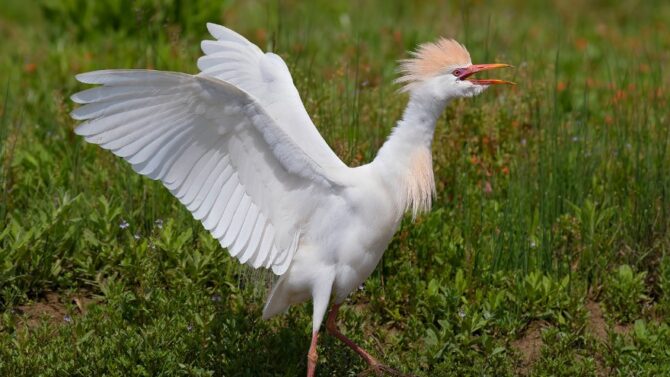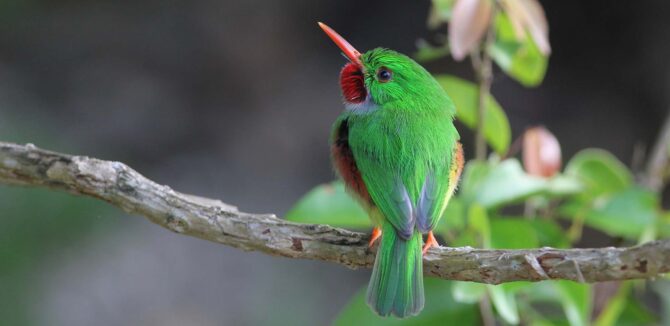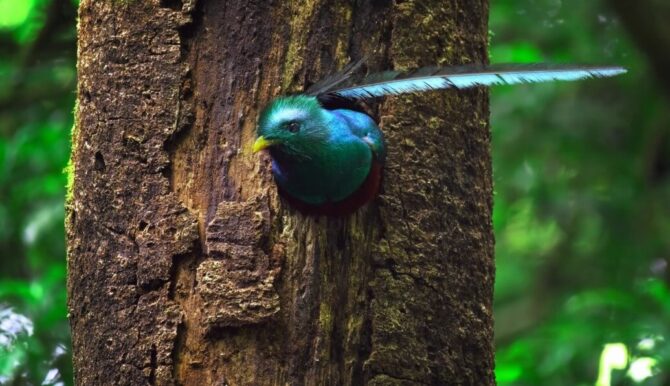There are birds in different colors, ranging from yellow and purple to white and black. Civilizations and religions see white birds as symbols of something good.
In the Christian religion, for example, the white bird is a symbol of purity, grace, and a manifestation of the Holy Spirit. In Islam, it is seen as a sign of good deed, strength, balance, and clarity. Overall, they stand for happiness, peace, and innocence.
Extant white bird species include the snowy owl, cattle egret, snow goose, pelicans, and a host of others.
We’ve compiled a list of 30 beautiful white species of birds for your education and entertainment.
Beautiful White Birds
1. Snowy Owl
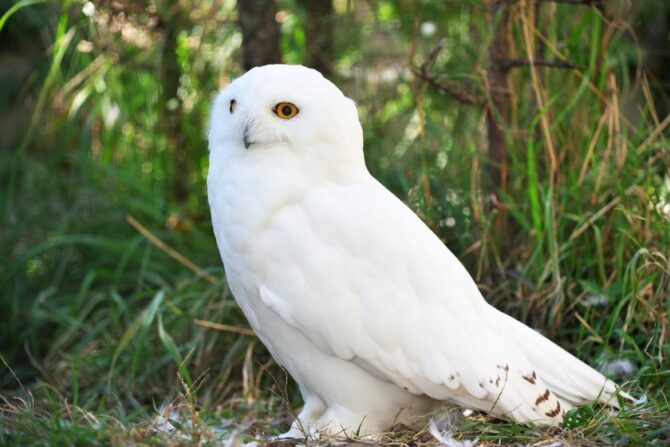
- Scientific Name: Bubo scandiacus
- Length: 20.7 to 28 inches
- Weight: 3.2 to 5.5 pounds
- Wingspan: 4 to 5 feet
- Habitat: Tundra, open trees
- Range: Artic regions of North America and the Palearctic
- Conservation Status: Vulnerable
One of the catchiest white birds is the snowy owl, mainly because it isn’t common to see a white owl. It is also known as the polar owl, the white owl, and the artic owl.
This bird lives in the Artic tundra of the United States and the Palearctic and sometimes migrates into the cities in the United States during winter. You get the chance to see it at that time.
The snowy owl has white plumage, but only a few individuals can claim to be white without a spot.
There’s a difference between sexes in the level of whiteness, as males tend to be whiter than females. Juveniles often have more gray spots, but as they grow older, they become whiter.
The bird is diurnal, unlike most owls which are nocturnal. Because it is active during the day, it hunts during that period. The snowy owl feeds on small mammals and water birds.
2. Cattle Egret

- Scientific Name: Bubulcus Ibis
- Length: 18 to 22 inches
- Weight: 9.5 to 18 ounces
- Wingspan: 34.5 to 38 inches
- Habitat: Farm, marshes, highway edges
- Range: Europe, South America, Asia, Africa, Australia
- Conservation Status: Least Concern
Cattle egrets are so named because of their relationship with cows, and they are often found where cattle are being herded.
They follow cows to feed on the insects that the cows kick up. This is an example of a commensalism symbiotic relationship.
So when you see a white bird hovering around cows, it is more likely a cattle egret. These birds have a wide range, occurring in Europe, Africa, Asia, and Australia.
They usually breed from California east to the Great Lakes and Maine down to the south of the Gulf Coast. Some individuals live in the United States, but they are not natives.
The white plumage is “stained” by some yellow, and the cattle egret has a yellow bill too.
3. American White Pelican
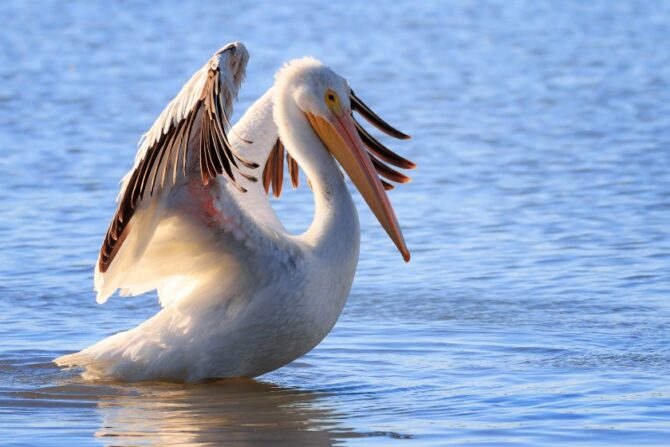
- Scientific Name: Pelecanus erythorhynchos
- Length: 50 to 70 inches
- Weight: 7.7 to 30 pounds
- Wingspan: 95 to 120 inches
- Habitat: Freshwater lakes, prairies, marshes
- Range: Southern California, Gulf States, Mexico
- Conservation Status: Least Concern
The American white pelican is one of the largest white birds in the world, and it is a native of the Americas, from the North to Central down to the South.
Its preferred habitats include freshwater lakes, prairies, and marshes, where it goes looking for the next meal. Diet consists more of fish, hence its closeness to water.
Every part of the American white pelican is long, from the wings to the legs and beak.
The whiteness of its plumage is broken by the black-tipped wings—though the tips are only visible in flight. Its bill and legs are colored orange, and underneath the bill, there is a throat sac.
Males and females are very similar, except in size. Males are generally the larger sex and have longer bills.
4. Snow Goose
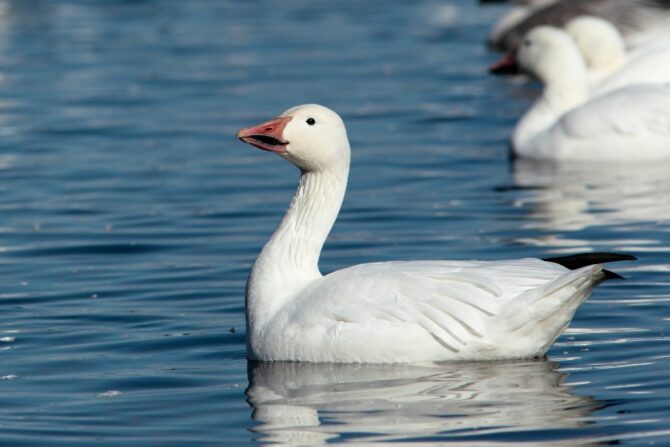
- Scientific Name: Anser caerulescens
- Length: 25 to 31 inches
- Weight: 4.5 to 7.1 pounds
- Wingspan: 53 to 65 inches
- Habitat: Tundra, marshes, ponds, bays
- Range: North America, Russia
- Conservation Status: Least Concern
The snow goose is named because of its white coat, but not all individuals have this coat. There are two morphs, white and dark, and only the white morph has white plumage.
The dark morph is called the blue goose, and it sports bluish-grey feathers. In addition to the morphs, there are also two subspecies distinguished by size: the lesser and greater snow geese.
The snow goose is predominantly white except for the black wing tips. This color pattern is similar to that of the American white pelican.
In physical structure, the snow goose has a long neck, with an orange bill and legs.
Both color morphs were once thought to be separate species, but no longer. Only the subspecies are under debate. The snow goose is a herbivore.
5. Snowy Egret
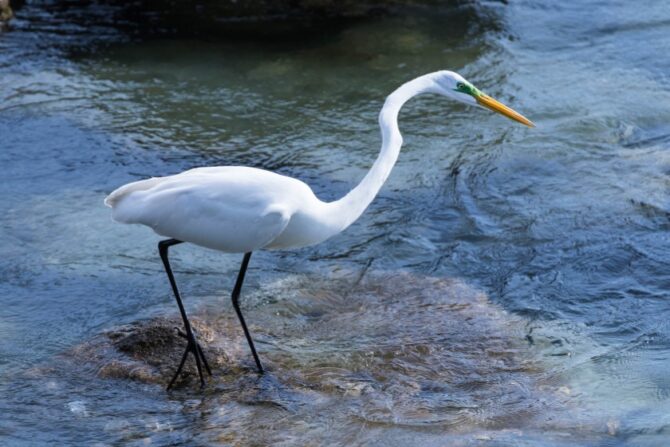
- Scientific Name: Egretta thula
- Length: 22.1 to 26.0 inches
- Weight: 13.1 ounces
- Wingspan: 41 inches
- Habitat: Marshes, riverbanks, pools, lakesides
- Range: Americas
- Conservation Status: Least Concern
The snowy egret is a small white heron similar to the little egret, which appears on our list too. It is native to North, Central, and South America.
At a period in history, this animal was hunted down for its white feathers to decorate women’s hats. This affected the snow egret’s population, but it rebounded after a while.
Besides the yellow lores on the face, the snowy egret is completely white. The feathers on the nape and neck look shaggy and are called aigrettes. The male and female are similar, though the male is a bit bigger.
The snowy egret is an omnivore, feeding on fish, shrimp, crayfish, snails, and many aquatic plants.
6. White Tern
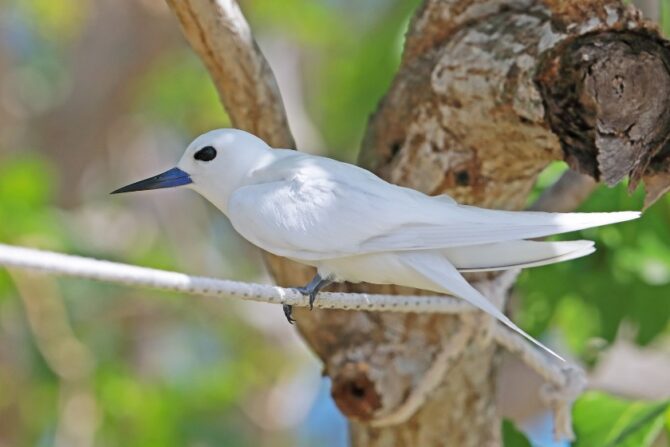
- Scientific Name: Gygis Alba
- Length: 8.3 to 9.1 inches
- Weight: 1.3 to 1.9 ounces
- Wingspan: 30 to 34 inches
- Habitat: Coast, wooded areas
- Range: Chile, Colombia, New Zealand, Asia
- Conservation Status: Least Concern
The white tern goes by a host of other names like fairy tern, angel tern, white noddy, and the common white tern.
It is linked to the little white tern, which used to be a subspecies but has since become a species of its own. Just as its name shows, the white tern is a flying image of white.
The whole plumage is white, making the tern even whiter than most of the birds we’ve mentioned so far. Only the eyes and bill are black.
You’d often find white terns close to coasts as they feed on small fish, and they are sometimes prey to giant tortoises.
7. Smew

- Scientific Name: Mergellus albellus
- Length: 15 to 17 inches
- Weight: 1.1 to 2 pounds
- Wingspan: 22 to 27 inches
- Habitat: Lakes, pools, rivers
- Range: Europe, Palearctic
- Conservation Status: Least Concern.
The smew is a duck species, the only one in its genus Mergellus. It isn’t a very popular bird but is admired nonetheless.
It seems to be a very old bird or at least has an ancestry that dates back to 13 million years ago.
This species is sexually dimorphic, with only the males being white. Females are colored grey, as well as juvenile males.
Only the adult male has white plumage combined with black in a panda-like manner. Not surprisingly, the male smew is more attractive than the female.
The smew is an omnivore with a wide diet. It feeds on aquatic plants, small fish, snails, crabs, etc.
8. White-bellied Sea Eagle
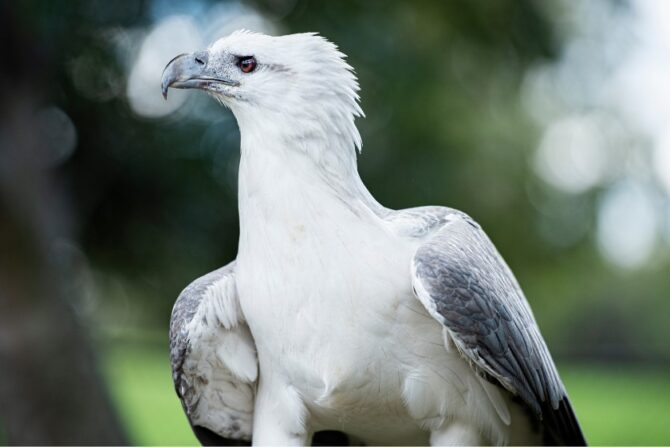
- Scientific Name: Haliaeetus leucogaster
- Length: 26 to 31 inches
- Weight: 4.0 to 6.6 pounds
- Habitat: Coastal areas
- Range: Asia, Australia
- Conservation Status: Least Concern
The white-bellied sea eagle is also known as the white-breasted sea eagle, and it is a bird of prey in the Accipitridae family.
It isn’t as white as others we’ve mentioned on this list, but given the white belly, it is a candidate for this list. This bird occurs in Asia and Australia. In the latter, indigenes revere the bird.
The upper parts of the white-bellied sea eagle are grey, but the underneath is white. Its head and tail are also white, and in-flight one can easily see how the black-and-white color combines.
This bird is diurnal and migratory. As a bird of prey, it feeds mainly on fish, turtles, and sea snakes. However, it also eats mammals and birds.
9. Tundra Swan
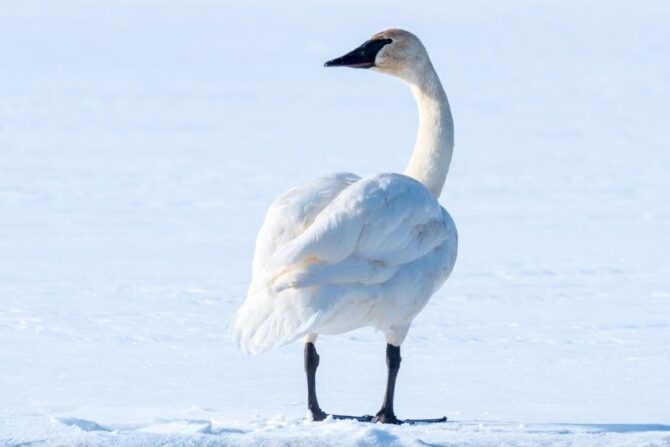
- Scientific Name: Cygnus columbianus
- Length: 45 to 59 inches
- Weight: 7.5 to 21.2 pounds
- Habitat: Arctic tundra
- Range: North America
- Conservation Status: Least Concern
The tundra swan is a small swan that stays in the Artic tundra. It lives in North America, specifically in countries like Mexico and Canada.
The tundra swan has two subspecies which are sometimes two species: the Bewick’s swan and the whistling swan. Bewick was named after an engraver Thomas Bewick.
Swans are generally white, and the tundra swan isn’t an exception. Its plumage is white on both the Bewick and the whistling swans, but the legs and bills are black.
The younger ones have grey mixed in the feathers, and the grey lightens as the tundra swan grows.
10. Ivory Gull

- Scientific Name: Pagophila eburnea
- Length: 15.8 to 16.9 inches
- Weight: 15.8 to 24.2 ounces
- Wingspan: 42.5 to 47.2 inches
- Habitat: High arctic
- Range: Greenland, North America,
- Conservation Status: Near Threatened
The ivory gull is the only species in the pagophila genus, and its range is wide, extending from North America to Greenland down to Europe and Asia.
In North America, the ivory gull breeds in the Canadian Arctic. It is migratory, going a short distance south during the autumn.
Unlike other gulls with black backs, the ivory gull has an all-white plumage. Only its legs and bill are colored differently.
The juveniles have black flecks on their wings and tail. It takes 2 years for an ivory gull to be an adult, and the color brightens.
The bird feeds on fish, crustaceans, eggs, rodents, and small chickens. As an opportunist, it goes after what prey is available.
11. Red-billed Tropicbird
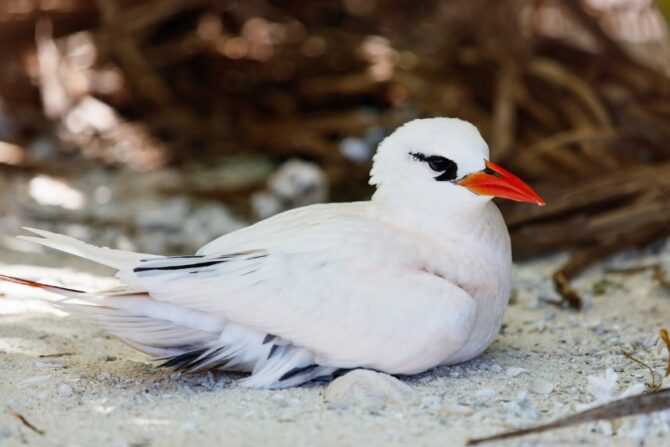
- Scientific Name: Phaethon aethereus
- Length: 35 to 41 inches
- Weight: 0.9 to 1.7 pounds
- Wingspan: 44 inches
- Habitat: Islands
- Range: Atlantic, Pacific, Indian
- Conservation Status: Least Concern
The red-billed tropicbird lives on islands close to oceans, and it is related to the seabird. It bears some resemblance to the tern, but not in every way.
The red-billed tropicbird is named after one of its obvious physical features, its red bill.
This bird is predominantly white and only has a black pattern on the back and wings. Then there’s the bill.
Its long tail is also white and gives it the slight appearance of a white dinosaur. It flies fast, going up to 27mph.
But on the ground, it isn’t so proficient as it doesn’t walk well. It easily floats on water as its plumage is waterproof.
12. White Cockatoo

- Scientific Name: Cacatua alba
- Length: 18 inches
- Weight: 14 to 28 ounces
- Habitat: Lowland tropical rainforests
- Range: Indonesia
- Conservation Status: Endangered
The white cockatoo is also known as the umbrella cockatoo, and it is found only on the islands of Indonesia.
On these islands, its habitat is further narrowed to tropical rainforests. Unsurprisingly, the white cockatoo is classified as endangered by the IUCN.
The white cockatoo has some relatives such as the yellow-crested, sulfur-crested, or salmon-crested cockatoos.
True to its name, the white cockatoo sports white feathers. That said, there are some yellow colors on some parts of the large wing feathers.
Sitting at the top of its head is a feather crest that becomes obvious when the white cockatoo is surprised at something.
This bird feeds a lot on plant materials like nuts, seeds, fruits, and berries. It can also feed on insects and the insect larvae themselves.
13. Little Egret
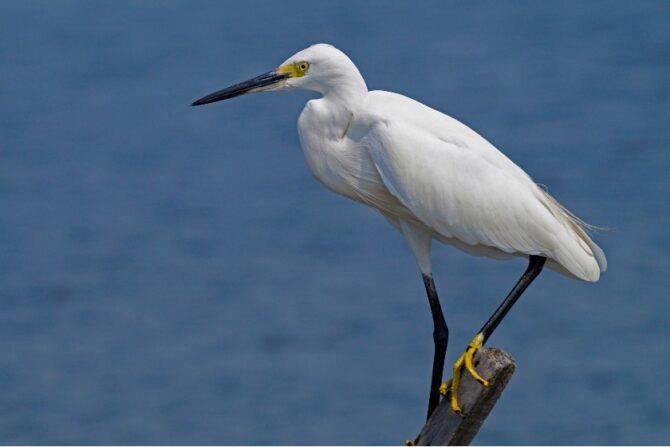
- Scientific Name: Egretta garzetta
- Length: 22 to 26 inches
- Weight: 12 to 19 ounces
- Wingspan: 35 to 42 inches
- Habitat: Lakes, rivers, ponds
- Range: Europe, Africa, Asia, Australia
- Conservation Status: Least Concern
The little egret is a species of small heron with a wide range of habitats, including lakes, ponds, rivers, canals, ponds, marshes, and lagoons.
This bird is aquatic, and its dietary choices reflect this. The little egret is found on different continents from Asia to Australia.
These birds usually come with white feathers, but there are individuals with bluish-grey plumage.
Its legs are long and black, similar to the black bills. Juveniles are often not as white as adults, having some grey or brown feathers. The little egret is migratory in some parts of the world.
14. White Ibis

- Scientific Name: Eudocimus albus
- Length: 21 to 28 inches
- Weight: 1.6 to 2.2 pounds
- Wingspan: 35 to 41 inches
- Habitat: Coastal marshes, wetlands, mangrove swamps
- Range: Americas
- Conservation Status: Least Concern
The full name of the white Ibis is the American white ibis, which points to its range.
This bird occurs in the North, Central, and Southern parts of America, specifically in countries like Mexico, Colombia, Venezuela, and Texas.
It stays close to water, getting its dietary satisfaction from aquatic animals like fish and small insects.
Only the long bill, eyes, legs, and wingtips are not white; every other part of the white ibis is. Males and females are similar in appearance, so it is hard to tell them apart.
The only way you can is through its size. Males are larger than females, and they have stouter bills.
15. American Pekin
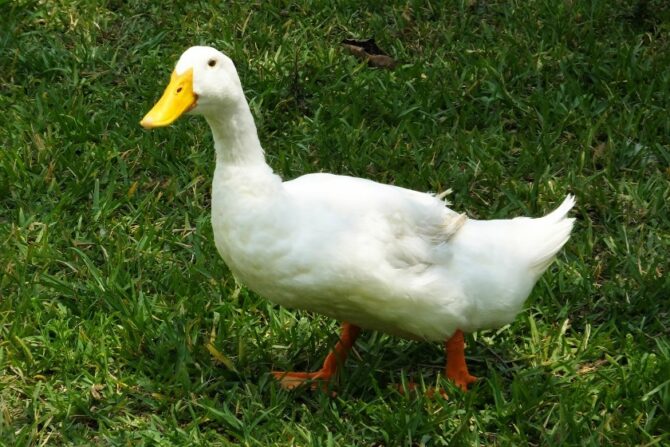
- Scientific Name: Anas platyrnhynchos domesticus
- Length: 20 inches
- Weight: 8 to 10 pounds
- Wingspan: 26 to 30 inches
- Habitat: Ponds, farms, parks
- Range: United States
- Conservation Status: Not at risk
The American Pekin was exported into the United States from China, and it was tagged American to differentiate it from the German Pekin (which also came from China).
The American Pekin is also called the Long Island duck because a lot of them are reared on Long Island, New York.
The American Pekin has a milky white plumage, though the duckling is colored yellow.
The legs and bill of both the duckling and the adult are orange. Additional features include a large head, a thick neck, and a short beak.
The ancestor of the American Pekin was called shin-chi-ya-Tze, bred by the Chinese alongside other breeds.
This was after the domestication of the mallard duck, dated 3000 years ago. The American Pekin is currently raised for meat, and you’d find it in commercial farms.
16. Northern Gannet
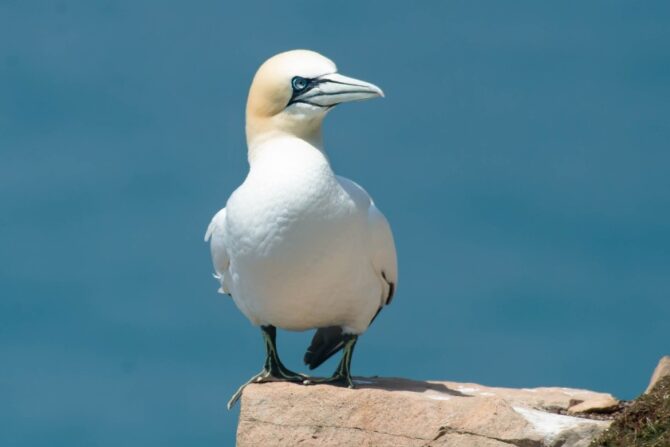
- Scientific Name: Morus bassanus
- Length: 34.5 to 39.5 inches
- Weight: 5 to 8 pounds
- Wingspan: 67 to 71 inches
- Habitat: Sea cliffs
- Range: North America, Europe
- Conservation Status: Least Concern
The northern gannet is a seabird found in the continents of North America and Europe.
It is the largest seabird in the North Atlantic, and you’d find its nests on both sides of the Atlantic Ocean.
It is also the largest gannet. Countries that host the northern gannet include Canada, Scotland, and France.
The northern gannet is white, just like others on this list. However, the wingtips are black or dark brown.
Again, following the pattern of other white species of birds, juveniles come with a grey-brown plumage that becomes white as time goes on.
17. Wood Stork
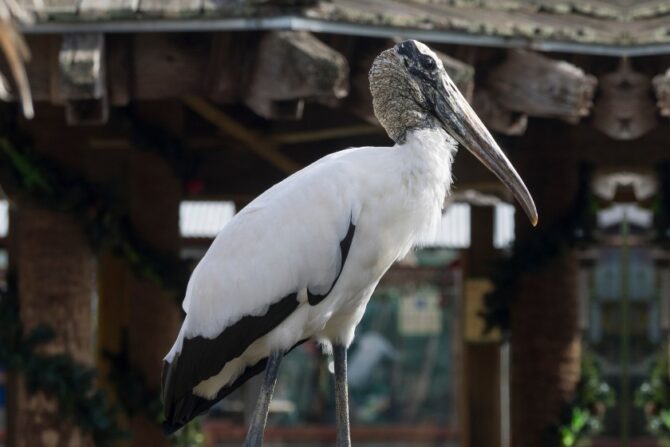
- Scientific Name: Mycteria Americana
- Length: 33 to 45 inches
- Weight: 4.4 to 7.3 pounds
- Wingspan: 55 to 71 inches
- Habitat: Lake, stream, mangrove forests
- Range: Americas, the Caribbean
- Conservation Status: Least Concern
The wood stork was once called the wood Ibis, but that changed, possibly because the wood stork is no longer an ibis.
It is a native of the Americas and can be found in the North, South, and even the Caribbean. It thrives in a tropical or subtropical climate and nests in colonies.
The wood stork is mostly white, but not all parts of its plumage are white. Its tail and part of the wing feathers are black, but the sheen is greenish-purplish.
The juvenile wood stork is also white, but its bill differs from that of the adult.
18. Trumpeter Swan
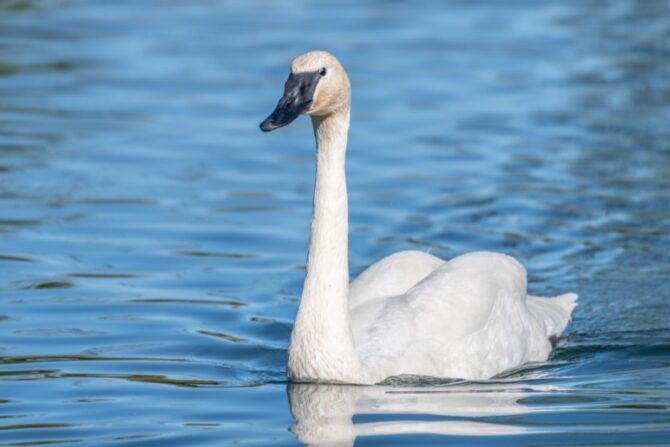
- Scientific Name: Cygnus buccinator
- Length: 4 ft 6 to 5 ft 5
- Weight: 15 to 30 pounds
- Wingspan: 6 ft 2 to 8 ft 2 inches
- Habitat: Shallow ponds, lakes, pristine wetlands
- Range: North America
- Conservation Status: Least Concern
The trumpeter swan is the heaviest living bird in North America, where it is a native.
It is also the largest living waterfowl species, which entails that you should expect to see a large bird when you meet the trumpeter swan.
The trumpeter swan is currently classified as the least concern, but as of 1933, that wasn’t the case.
There were only about 70 left, and it faced extinction. Fortunately, it survived and thrived.
The trumpeter swan is how you’d imagine a swan to be, complete with the long neck and the ability to raise its body upwards. It also floats more on ponds and lakes, and besides its bill, it is colored white.
19. Barbary Dove
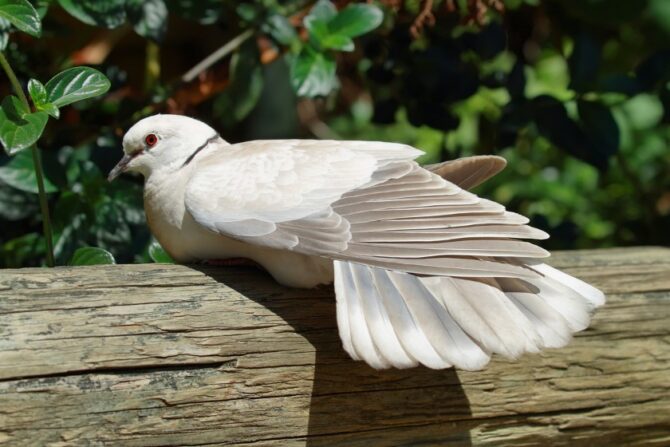
- Scientific Name: Streptopelia risoria
- Length: 12 inches
- Weight: 3.2 to 6.6 ounces
- Habitat: Farmlands, semi-deserts, woodlands
- Range: Africa
- Conservation Status: Domesticated
The Barbary Dove is also called the ring dove, the ring-necked turtle dove, the ringneck dove, and the ringed turtle dove.
It belongs to the dove and pigeon family known as the Columbidae. Unlike many other birds on this list, the Barbary dove is domesticated.
It is commonly found in Sub-saharan Africa, but as a domestic bird, it can be exported to other regions.
Not all Barbary doves are white. The white variants have a mutation that makes them so. White doves used for magic shows are usually Barbary doves.
There are some controversies regarding its status, mainly because of how easily it can form hybrids.
While some experts assert that it is the domesticated form of the Eurasian collared dove, others link it to the African collared dove.
20. Snow Bunting
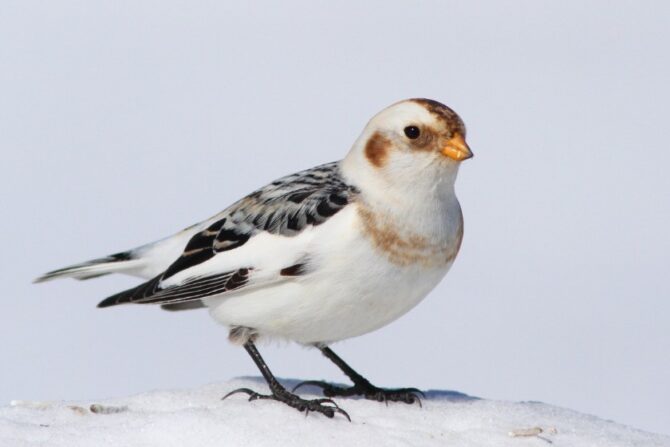
- Scientific Name: Plectrophenax nivalis
- Length: 5.9 inches
- Weight: 1.05 to 1.41 ounces
- Habitat: Arctic Tundra
- Range: Northern Hemisphere
- Conservation Status: Least Concern
Snow bunting is a passerine bird and an inhabitant of arctic regions around the northern hemisphere.
This bird is special in that it can run, jump and walk if needed. It also lives on the southern side but is limited by the climate.
Both the male and female snow bunting have white colors, but there are differences in their color patterns.
While the male snow bunting has a black wingtip and a black back, the female has a rufous back. The male only gets the rufous color in winter.
21. Great White Egret
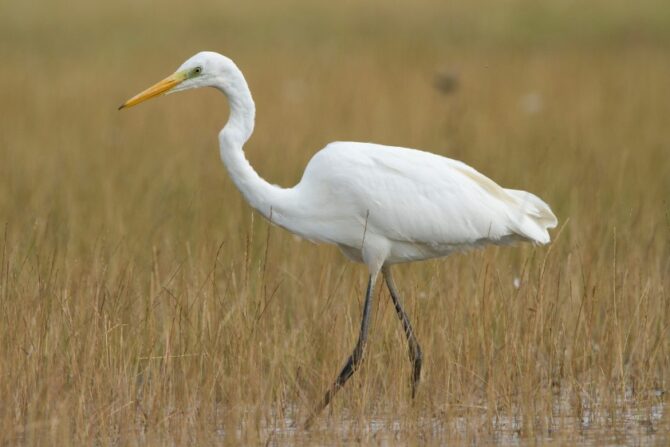
- Scientific Name: Ardea Alba
- Length: 30 to 41 inches
- Weight: 1.5 to 3.3 pounds
- Habitat: Marshes, ponds, mud flats, shores
- Range: The Americas, Africa, Asia, and southern Europe.
- Conservation Status: Least Concern
The great white egret is also known as the great white heron, the common egret, the large egret, or simply the great egret.
This bird is widely distributed, occurring in every continent except Antarctica and Australia.
You’d often find the great egret in tropical and temperate regions as it thrives more there.
When standing, the great egret looks like it is donning a white, feathery cloak. The great egret is similar to other white egrets, except that it has a yellow bill and black legs.
During the breeding season, its feathers look like ornaments. Males and females are identical.
22. White-tailed Kite

- Scientific Name: Elanus leucurus
- Length: 14 to 17 inches
- Weight: 8.8 to 13.4 ounces
- Wingspan: 35 to 40 inches
- Habitat: Savannas, open woodlands, marshes
- Range: Americas
- Conservation Status: Least Concern
The white-tailed kite is a native of Western North America and can also be found in certain parts of South America.
It has some relatives, like the black-winged kite. In the 1930s and 1940s, this bird almost got extinct in California. Fortunately, it has become common again.
The white-tailed kite’s upper parts aren’t white, but the breast area is. The upper parts are colored black, so overall it endearingly combines the classic black-and-white color.
Another feature it has is the round tail. It flies like a falcon, and it is easy to confuse the two in flight.
23. Royal Spoonbill
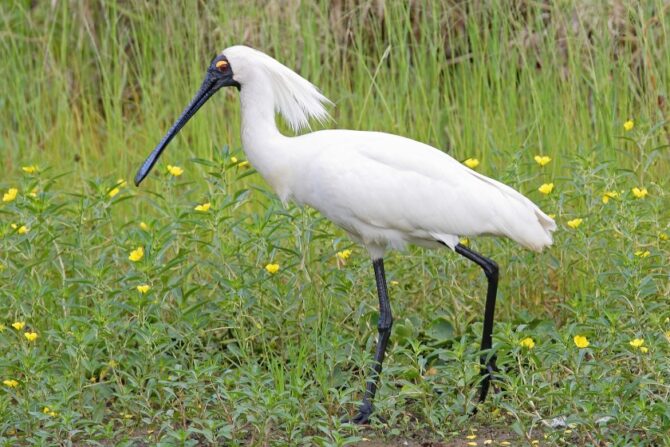
- Scientific Name: Platalea Regia
- Length: 29 to 32 inches
- Weight: 3.1 to 4.6 pounds
- Wingspan: 28 to 34 inches
- Habitat: Freshwater and saltwater wetlands
- Range: Northern mainland Australia
- Conservation Status: Least Concern
The royal spoonbill is also known as the black bill spoonbill, and from the pictures, it’s easy to see why.
It lives in places like Australia, New Zealand, Indonesia, Papua New Guinea, and the Solomon Islands.
You’d often find it in wetlands, both saltwater, and freshwater. This is where it finds its meal in the form of crustaceans, fish, and insects.
The royal spoonbill is white except for its legs and bills, the latter of which is very conspicuous.
The beak is shaped like a spoon, which explains its name. The legs are long and convenient for wading through water.
24. Gyrfalcon

- Scientific Name: Falco rusticulus
- Length: 19 to 24 inches
- Weight: 1.12 to 2.15 pounds
- Wingspan: 4 feet
- Habitat: Tundra, mountains
- Range: North America, Europe, Asia, Iceland
- Conservation Status: Least Concern
The Gyrfalcon is a bird of prey that is considered the largest falcon species, and it lives in the arctic tundra as well as mountains.
The continents it occurs in include North America, Europe, Iceland, and Asia. As a bird of prey, it hunts down animals like waterfowl, fish, and mammals.
This bird’s color varies based on location, leading to various morphs like white, brown, silver, and black.
The white morph comes with black-spotted wings. Because of its multiple colors, the gyrfalcon is termed polymorphic.
25. Mute Swan
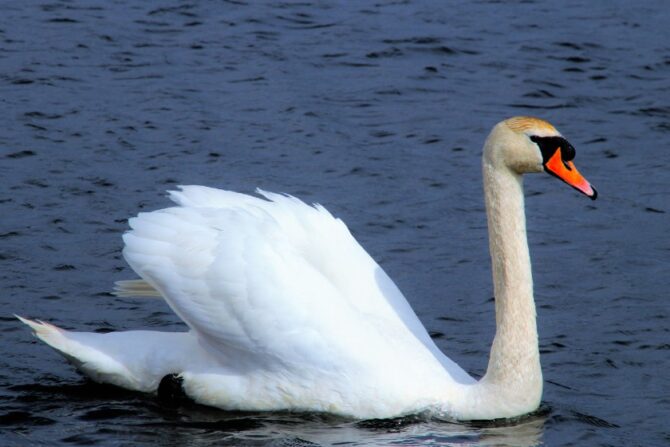
- Scientific Name: Cygnus olor
- Length: 49 to 63 inches
- Weight: 20 to 32 pounds
- Wingspan: 82 to 94 inches
- Habitat: Urban lakes, farm ponds, coastal estuaries
- Range: Africa, Europe, Siberia
- Conservation Status: Least Concern
The mute swan is a member of the family Anatidae. It occurs more in Europe and Siberia, but on rare occasions, it visits Africa too.
It is called a mute swan because it is quieter than other swans who are known to be quite vocal. The only swan bigger than this species is the trumpeter swan, and they are a bit alike.
The mute swan is white all over, just as you’d expect from swans. Its bill, eyes, and legs are the only places with a different color.
The beak is colored yellow and black, with a knob that stays at the top of it. This knob is larger in males than females, and the male is also bigger.
26. Whooping Crane
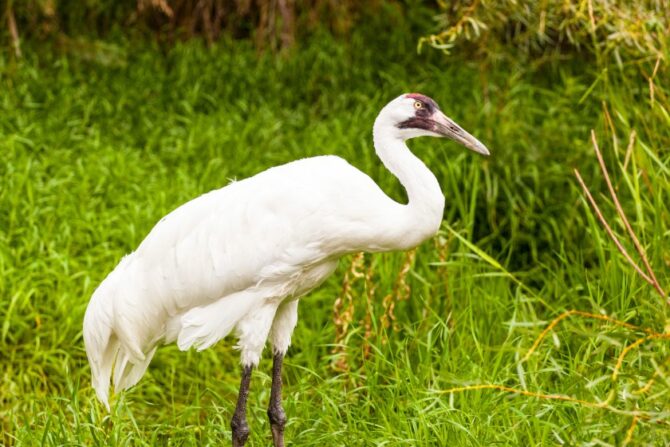
- Scientific Name: Grus Americana
- Length: 45 inches
- Weight: 14 to 16 pounds
- Wingspan: 7 to 8 feet
- Habitat: Wood Buffalo National Park
- Range: North America
- Conservation Status: Endangered
The whooping crane is a native of North America, and it is the only one out of two cranes that are natives of the continent.
This bird is classified as endangered by the IUCN due to hunting and habitat loss that persisted over the years.
Conservation efforts have led to some increase, but the whooping crane remains in need of protection.
The whooping crane’s plumage is white except for the black wingtips and equally black tail. Its bill is also not white, going instead with black. Then there’s the red crown.
27. European Herring Gull
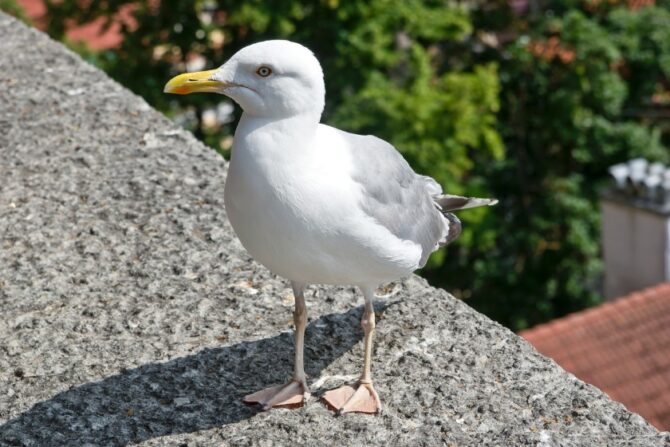
- Scientific Name: Larus argentatus
- Length: 26 inches
- Weight: 2.3 to 3.3 pounds
- Wingspan: 49 to 61 inches
- Habitat: Coast, lakes, reservoirs
- Range: Europe
- Conservation Status: Least Concern
The European herring gull is widespread in Europe, as the name shows. It goes from the North to Central and East Europe.
Some individuals are migratory, but others are permanent residents in their range.
The European herring gull is currently classified as the least concern despite the effect hunting had on its population in the past.
The upper parts and wings of the European herring gull aren’t white but rather a light grey. The head and underparts are white, while the wingtips are spotted.
28. Willow Ptarmigan

- Scientific Name: Lagopus Lagopus
- Length: 14 and 17 inches
- Weight: 15 to 29 ounces
- Wingspan: 24 to 26 inches
- Habitat: pine and birch forests, tundra, mountain slopes
- Range: North America, Asia, Europe
- Conservation Status: Least Concern
The willow ptarmigan had a wide range, moving across North America, Asia, and Europe.
Countries where you can find it includes Canada, China, the United States, the Czech Republic, Mongolia, Finland, and Norway. It inhabits areas like tundras and mountain slopes in these countries.
The willow ptarmigan has marbled brown feathers on the upper parts, but the belly is colored white. The wing feathers are white as well.
29. Ross’s Goose
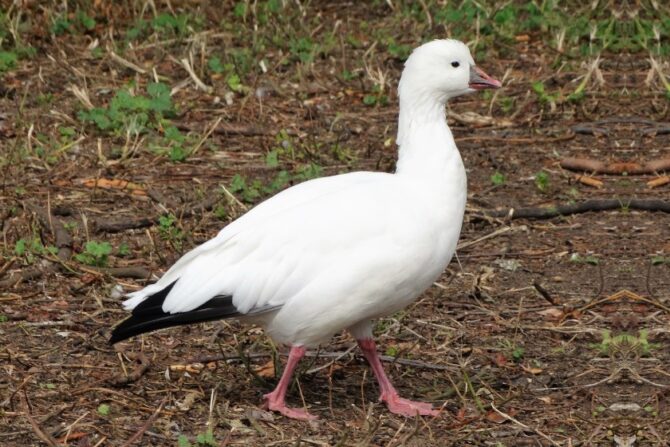
- Scientific Name: Anser rossii
- Length: 22.6 to 25.2 inches
- Weight: 42.3 to 55.3 ounces
- Wingspan: 44.5 to 45.7 inches
- Habitat: Arctic Tundra
- Range: North America
- Conservation Status: Least Concern
The Ross’s goose is one of three white geese that breed in North America, and it is the smallest of the three.
It is similar to the snow goose in looks, but there are some differences, like the bill size. The Ross’s goose was named in honor of a man named Bernard R. Ross.
The Ross’s goose is colored white in many areas except the black tail. The bill and legs are orange, also deviating from the white plumage.
The population faced a decline in the early 1950s due to hunting but has since gotten back on track after getting protected.
30. Red-vented Cockatoo

- Scientific Name: Cacatua haematuropygia
- Length: 12 inches
- Weight: 0.66 to 2.65 pounds
- Wingspan: 8.6 inches
- Habitat: Rainforest, Mangrove swamps
- Range: Philippines
- Conservation Status: Critically Endangered
The red-vented cockatoo is also known as the Philippine cockatoo, as well as some other local names like katala, agay, and abukay. It can be found only in the Philippines as its population is low.
Thanks to illegal pet trades and environmental issues, the red-vented cockatoo is currently classified as critically endangered.
The red-vented cockatoo has an all-white plumage, the only exceptions being the undertail and underwings, which are yellow.
It is known to be quieter than other cockatoos but occasionally makes a screeching noise.
Wrap Up
White birds are admirable for different reasons, and they symbolize a lot of positive qualities.
It is for this reason that we compiled these white species that can be found in different regions of the world.
From pure white species to those with many color patterns, these birds are part of nature’s masterpieces.
